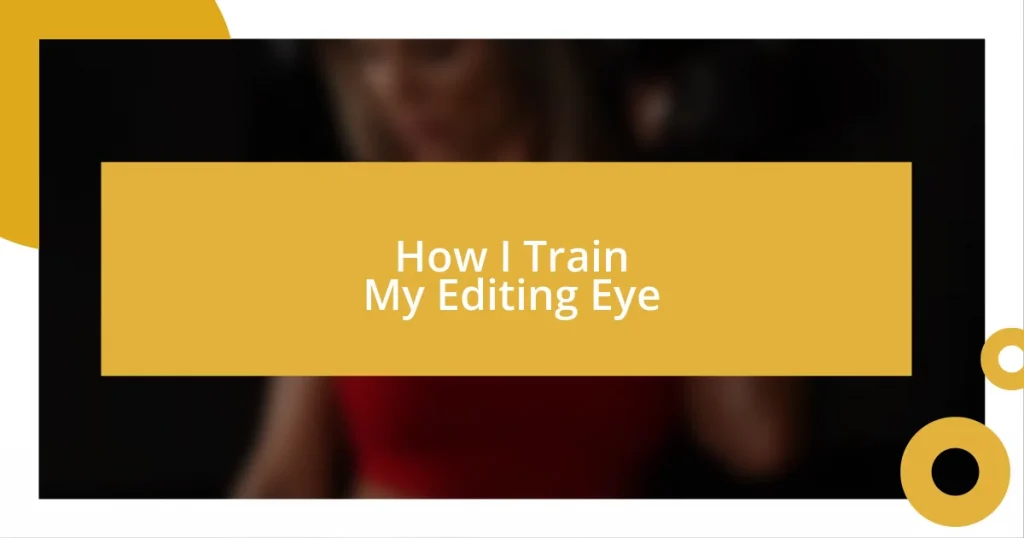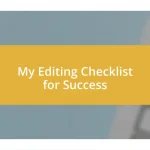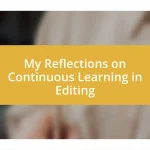Key takeaways:
- The development of an “editing eye” involves deliberate observation, practice, and humility, leading to more effective storytelling.
- Key editing skills include attention to detail, structural awareness, consistency checking, clarity, and the ability to incorporate feedback.
- Utilizing technology and creating a personal editing checklist streamline the editing process and enhance narrative authenticity and coherence.

Understanding the Editing Eye
The editing eye is a unique skill that develops over time, shaped by experience and a keen awareness of detail. I remember early on in my editing journey, I would often miss glaring mistakes and inconsistencies. Have you ever looked back at something you wrote months ago and felt a pang of embarrassment from unnoticed errors? That feeling motivated me to refine my approach.
One of the most illuminating moments for me was when I critiqued a friend’s manuscript; I spotted nuanced issues that I had previously overlooked in my own work. It’s fascinating how a fresh perspective often reveals what we can’t see in our own writing. I’ve learned that training the editing eye requires a blend of instinct, practice, and a bit of humility—acknowledging that there’s always room for improvement.
To truly understand the editing eye, I believe we must cultivate a habit of deliberate observation. I often find myself questioning every word, asking things like, “Does this truly serve the narrative?” or “Is the structure effective for the reader?” This continuous inquiry transforms editing into a reflective process, making it less about correction and more about crafting a powerful story.
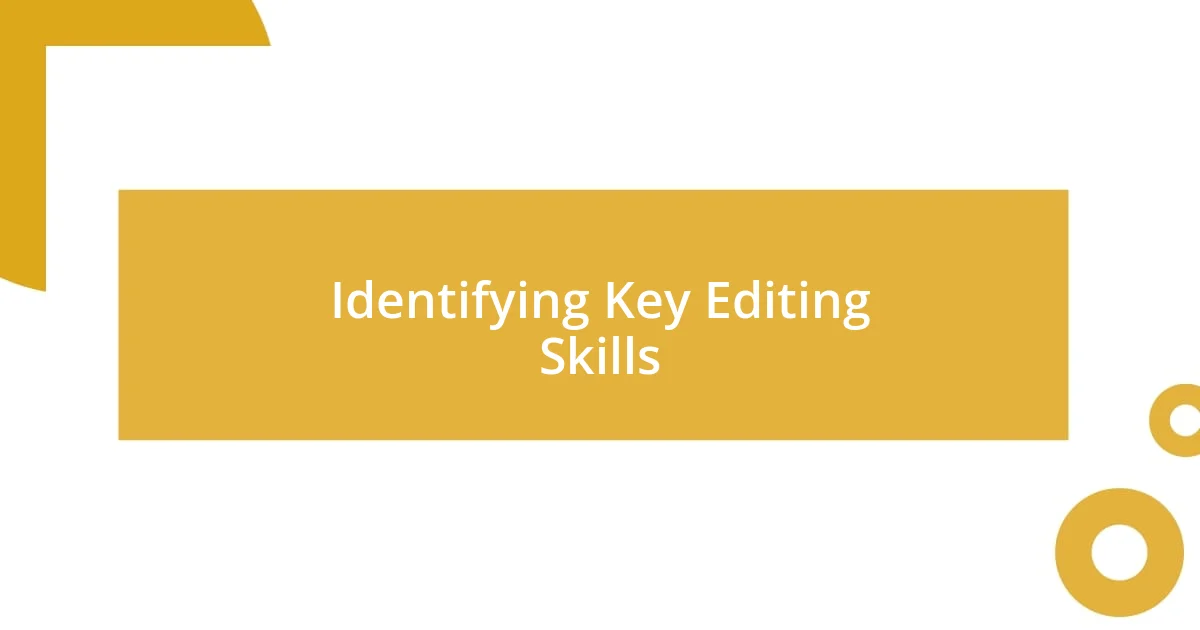
Identifying Key Editing Skills
Identifying key editing skills is crucial for honing that editing eye. Over the years, I’ve found that certain abilities consistently rise to the forefront of effective editing. For instance, recognizing grammatical errors, understanding narrative flow, and being able to detect inconsistencies within the text are skills that I’ve worked hard to develop. One particular experience that stands out for me was editing a short story for a local contest; it was eye-opening to see how pivotal clarity and coherence were in capturing the readers’ interest.
Here are some essential editing skills that I believe every editor should focus on:
- Attention to Detail: Noticing small mistakes that can undermine credibility.
- Structural Awareness: Understanding how the overall organization of a piece influences storytelling.
- Consistency Checking: Ensuring that elements like tone, style, and character development remain uniform throughout.
- Clarity Vision: The ability to clarify complex ideas without losing the essence of the message.
- Feedback Incorporation: Using critiques as a tool for improvement, rather than taking them personally.
Each skill contributes to the richness and impact of the written word, and developing them has been a transformative journey for me. I find joy in witnessing my growth as I tackle more challenging edits, knowing that every piece I work on offers a lesson.
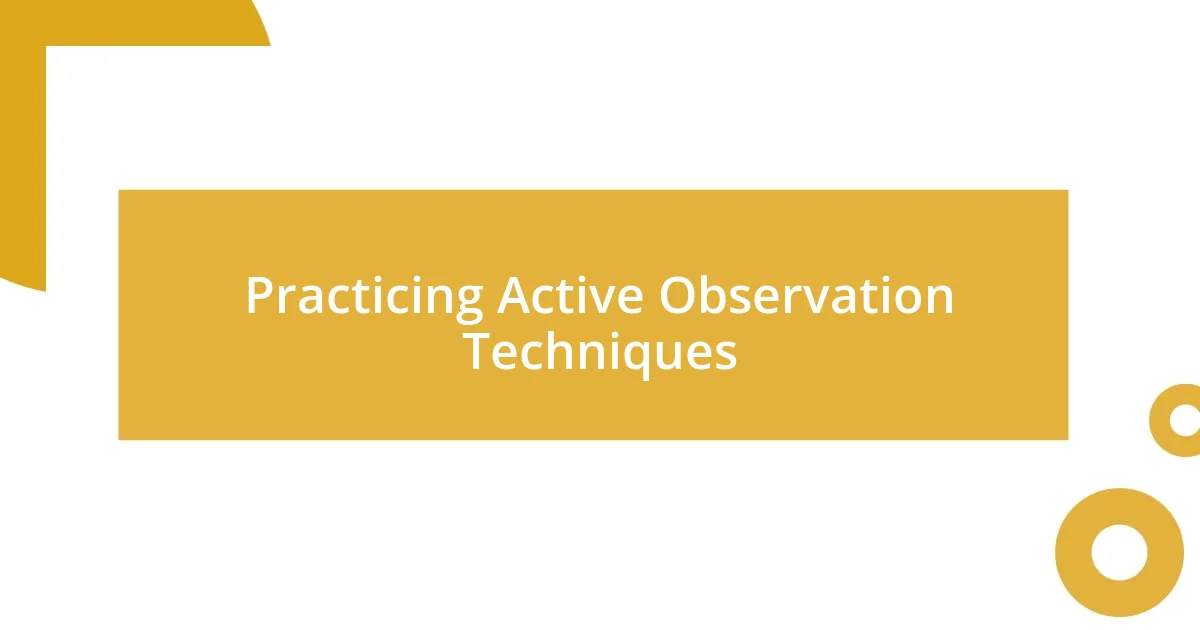
Practicing Active Observation Techniques
Practicing active observation techniques is immensely valuable for sharpening the editing eye. I often engage in exercises where I observe fonts, layouts, and the mechanics of how a story unfolds. Recently, while analyzing a popular novel, I focused not just on the plot but on how punctuation choices influenced the pacing. It struck me—how often do we overlook these subtleties? By actively dissecting a piece, it enhances my ability to identify similar features in my work.
When I’m editing, I make it a point to read aloud. This simple technique dramatically shifts my perception. I remember the first time I did this—I caught awkward phrases I had glossed over when reading silently. It was like unveiling a hidden layer of my writing! Listening to the flow helps me pick up rhythm and cadence, making the editing process feel dynamic rather than mechanical.
Another technique I use is conceptual mapping. I love to jot down main themes and characters on a board, visually connecting them. I recall dissecting a friend’s essay on social issues; mapping it out allowed me to see overlaps and gaps. This strategy enriched not only my understanding but also led to insightful discussions that deepened both our perspectives.
| Observation Technique | Description |
|---|---|
| Visual Analysis | Examining formatting, typography, and structure. |
| Reading Aloud | Listening to the text helps catch awkward rhythms and phrases. |
| Conceptual Mapping | Mapping out themes and characters to see connections. |

Reviewing and Analyzing Edited Work
When I sit down to review and analyze edited work, I often feel like I’m stepping into a new world each time. Recently, I revisited a piece that I had previously edited and was surprised by how differently I perceived it on the second reading. It made me wonder: how often do we find hidden gems in our own work once we step away and return with fresh eyes? This experience reinforced the importance of giving myself time before diving back into an edited piece; it gives me a chance to see things from a new perspective.
Analyzing altered content isn’t just about checking corrections; it’s about uncovering the heart of the piece. I remember editing a friend’s article about climate change, and while the grammar was polished, the emotional depth felt lacking. This made me realize that editing is not just fine-tuning words; it’s about enhancing the authenticity of the narrative. Did I truly grasp the writer’s intent? If not, I knew that merely polishing wouldn’t suffice; I needed to inject that emotional authenticity back into the text.
In each review session, I actively seek opportunities to learn, often asking myself what new insights I can glean. For instance, during one editing marathon, I took a moment to highlight sections that resonated with me emotionally. By revisiting these spots, I understood not just what worked but why it resonated. This technique keeps me engaged with the text, making the process feel collaborative rather than solitary. Have you ever noticed how identifying those powerful moments can transform your editing eye? That interplay between the editor and the writing truly fascinates me, reminding me that every piece of work has its own story to tell.

Utilizing Editing Software Tools
Utilizing editing software tools has become a game-changer in my process. One day, while testing out a new grammar tool, I realized it caught nuances I often missed. I found it fascinating how technology could highlight passive constructions. Have you ever wondered how many decisions we might overlook in our writing, simply because we’re too close to it?
Working with software like Grammarly or ProWritingAid allows me to streamline my editing workflow. When I first tried ProWritingAid, I was impressed by its detailed reports on elements like pacing and readability. That’s when it struck me: it’s not just about grammar; these tools enabled me to refine my voice. They empower me to make conscious choices about tone and style—something I didn’t fully appreciate before.
Moreover, I often leverage collaborative features within editing software. Sharing documents via Google Docs, I invite feedback from peers. I vividly recall collaborating on a project where a colleague’s comments opened my eyes to an unclear argument. That moment reminded me how invaluable outside perspectives can be—there’s something incredibly enriching about engaging with others while using these digital tools. How about you? Have you found that technology enhances your editing processes?

Creating a Personal Editing Checklist
Creating a personal editing checklist has been a transformative step in refining my editing process. I remember the initial struggle of sifting through endless drafts, unsure of what to focus on. So, I started jotting down key elements I wanted to prioritize, like clarity, coherence, and emotional impact. This simple act transformed my approach, allowing me to tackle edits systematically rather than getting lost in the weeds of the text.
One aspect I find essential on my checklist is to evaluate the flow of ideas. During one editing session for a short story, I identified awkward transitions that disrupted the narrative’s pace. It hit me how crucial smooth flow is to keep readers engaged. As I began addressing these hiccups, the story unfolded beautifully, and the satisfaction of witnessing the narrative come together was incredibly rewarding. Have you ever felt that rush of excitement when your edits reveal the heart of a story?
Another valuable component of my checklist is to scrutinize for consistency in tone and style. A while back, I edited a blog series where the initial entries had a playful tone, but the later ones felt more serious. This inconsistency threw off the reader’s experience. By including tone checks on my checklist, I ensure that every piece resonates authentically with the intended audience. Finding that balance opens up pathways for deeper connection with readers. How do you maintain consistency in your writing?










